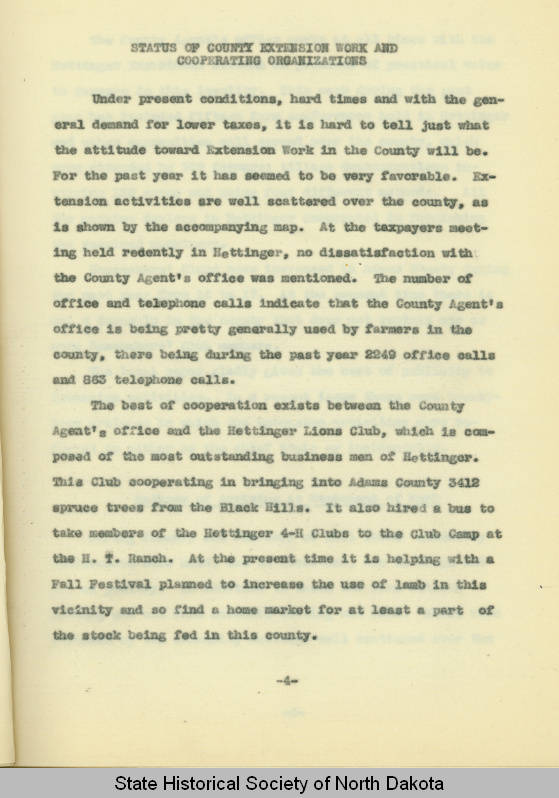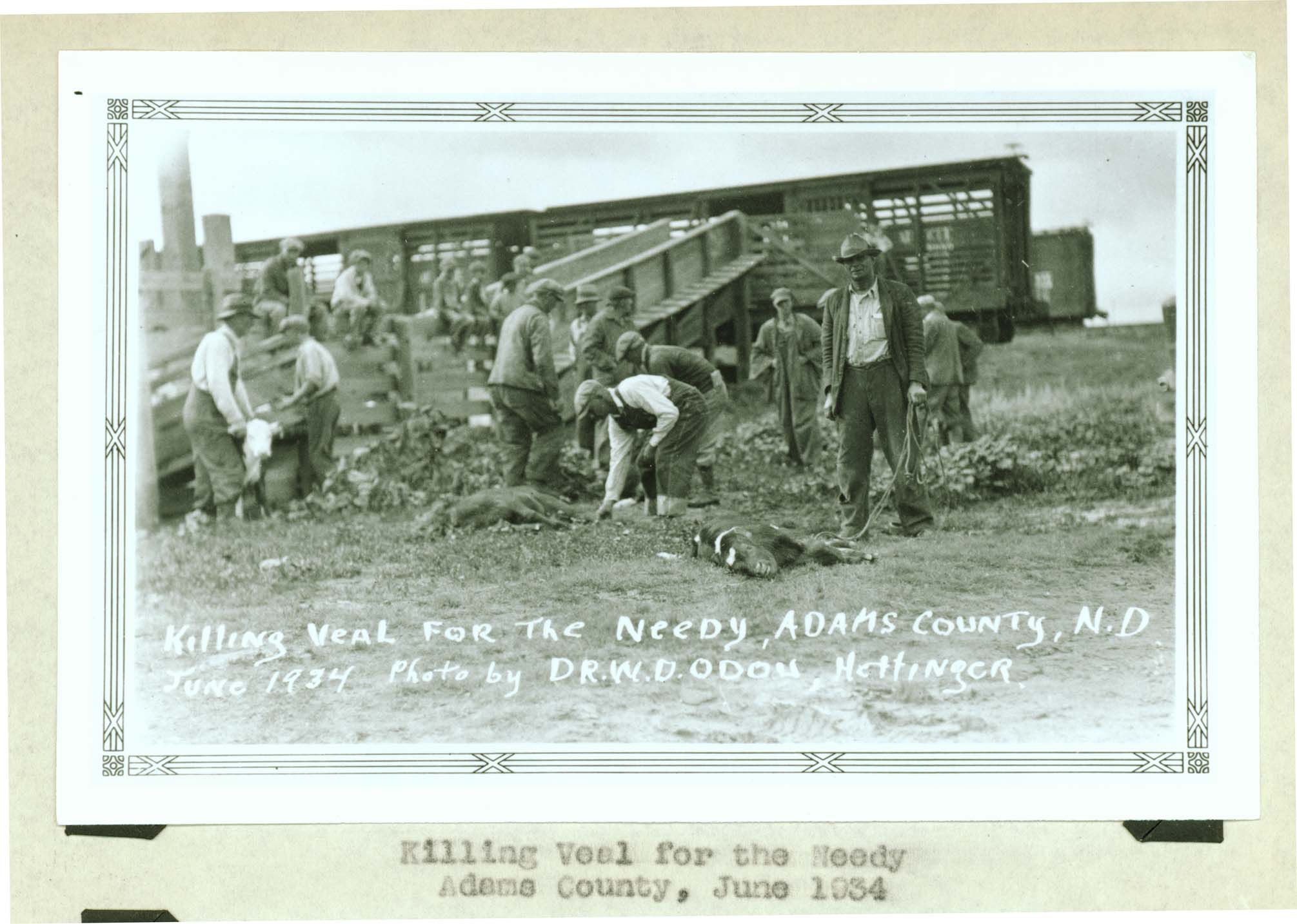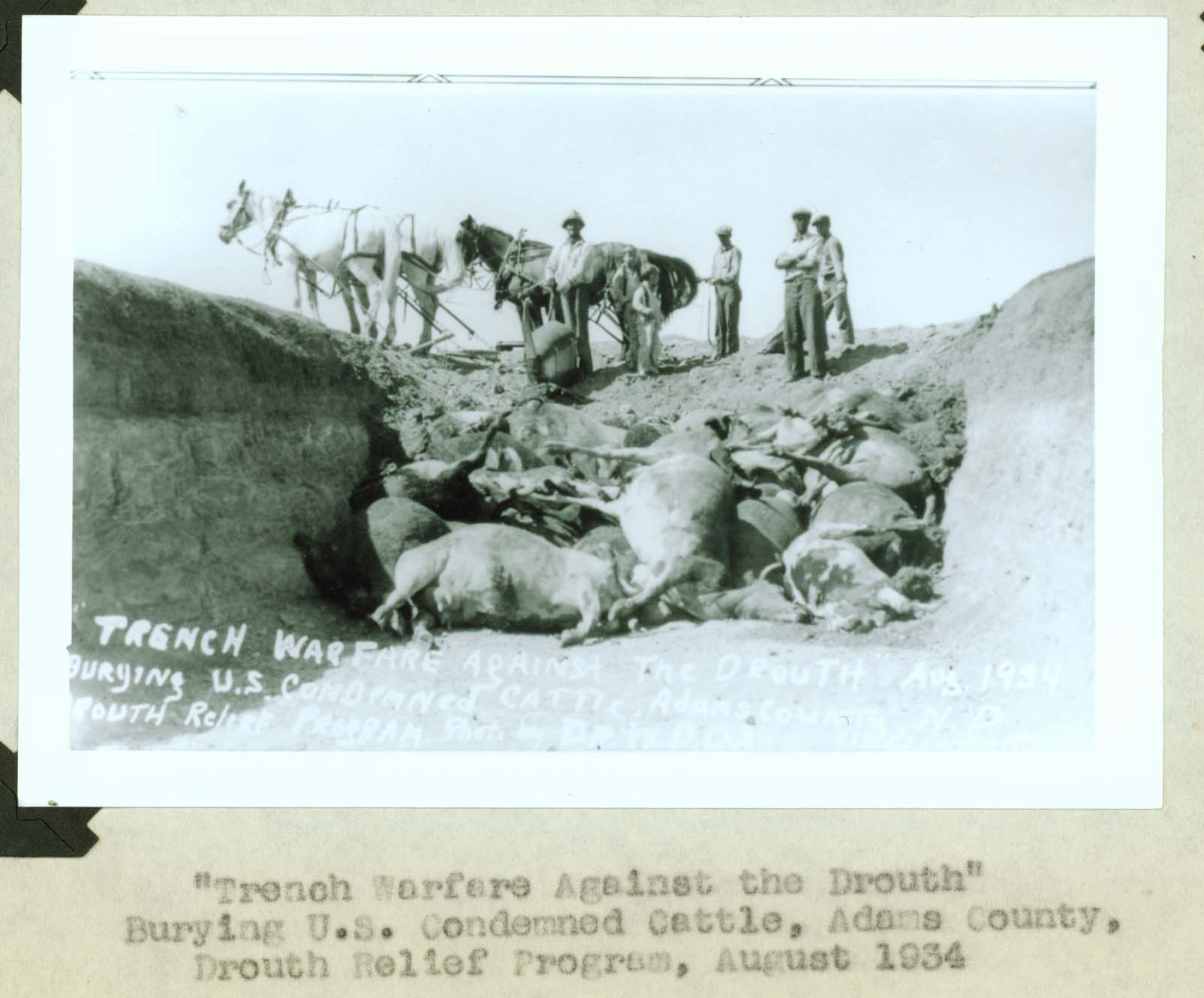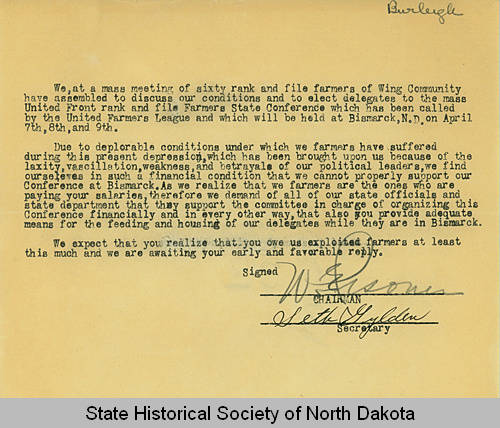The first supporting question, “What economic trends have influenced farming and ranching in North Dakota since 1900?” helps students use sources to unwrap the context of the time and topic being examined. Facilitate a discussion on the history of radicalization among farmers on the Great Plains. How did railroads and business interests in the east influence North Dakota farmers’ and ranchers’ businesses and their thinking? Complete the following task using the sources provided to build a context of the time period and topic being examined.
Formative Performance Task 1
Use the list created while staging the question to take a deeper dive into this topic. Create a timeline of major events, changes, and innovations in U.S. and world history that have had an impact on farming and ranching in North Dakota since 1900. What did farming and ranching look like in North Dakota before World War I, during the Great Depression, during World War II? What did they produce? What types of tools and equipment were available to them? What were some of the bigger issues and trends they faced? What are farming cooperatives. Why does North Dakota have a state mill and elevator, and a state bank? What kind of changes have influenced agriculture since World War II? What technological and political changes, trends, and other issues are influencing farming and ranching in North Dakota today?
Featured Sources 1
The sources featured below are primary sources. They are the raw materials of history—original documents, personal records, photographs, maps, and other materials. Primary sources are the first evidence of what happened, what was thought, and what was said by people living through a moment in time. These sources are the evidence by which historians and other researchers build and defend their historical arguments, or thesis statements. When using primary sources in your lessons, invite students to use all their senses to observe, describe, and analyze the materials. What can they see, hear, feel, smell, and even taste? Draw on students’ knowledge to classify the sources into groups, to make connections between what they observe and what they already know, and to help them make logical claims. Can those claims be supported by evidence from the materials? Further research of materials and sources can either prove or disprove the students’ argument.
Read featured sources A-D. In a group or as a class, answer the following questions: What type of sources are they (letters, photos, maps, diaries, etc.)? What kind of information do they contain? Who created each of these sources? Who was the intended audience for each source? Why were these sources created? When were the sources created? What do the sources tell us about farming during that time? How do we know? What else can be found? Study the sources for evidence showing drought and depression was becoming increasingly difficult for farmers. Identify specific sentences that support your findings.
| Source A |
Adams County Extension Agent Annual Reports: 1931, 1932, and 1934 
http://www.digitalhorizonsonline.org/digital/collection/uw-ndshs/id/3093 In 1914, Congress passed the Smith-Lever Act which formed the structural and financial foundation for the federal government’s efforts to improve agriculture and rural life throughout the nation. In 1918, each agricultural county was required to have an extension agent to help raise production and promote conservation of resources during World War I. After the war, each county could vote on whether to continue to support extension work. Adams County voted for an extension office in 1922. The agent held meetings with farmers to help them learn about new crops and to improve their farming methods. The extension office also supervised the activities of 4-H clubs and Homemakers Clubs. Adams County extension agent annual reports reveal some of the turmoil that seized North Dakota and the nation after the stock market crashed in 1929. By 1932, drought had begun to damage crops on the northern plains. By 1935, drought meant that farmers could not feed or water their cattle, sheep, hogs, or horses adequately. In 1932, with the economy weakened by bank closures, farm foreclosures, and high unemployment, Adams County voters decided to discontinue extension operations. However, in 1933, with the passage of the Agricultural Adjustment Act (AAA), every agricultural county in the US was required to have a county agent to administer the federal programs. Adams County again hired an agent. Included in this document set are excerpts from the Adams County agent’s reports of 1931, 1932, and 1934. These reports tell a grim story of increasing hardship in south west North Dakota as the drought (“drouth”) led to lower yields per acre of wheat, and higher numbers of grasshoppers which ate what little wheat sprouted. Arsenic-laced bran was used to kill grasshoppers causing farmers some concern for the safety of their livestock that might get into the poisoned grain. Adams County had been re-directing its agricultural efforts away from wheat and toward livestock operations, but the extreme drought caused cattle and sheep to starve. Federal programs to buy cattle, sheep, and hogs at rock-bottom prices were not popular, and the killing of cattle too weak to be shipped to distant markets made farmers angry. The drought ended in the late 1930s, and World War II raised prices and demand for wheat and other agricultural products. However, few North Dakotans who lived through the hard times of the 1930s would ever forget the desperation and sacrifices of those dark years. These sources can be found in the Adams County Extension Agent Annual Reports (SHSND Mss 40643). |
| Source B | 
|
| Source C | 
|
| Source D |
United Farmers League State Conference Records 
http://www.digitalhorizonsonline.org/digital/collection/uw-ndshs/id/3031 In late March 1934, farmers from different communities around western North Dakota sent letters to the heads of several state agencies, including the state library. The farmers demanded that state leaders support, with money and other resources, the expenses associated with a state conference of the United Farmers League (UFL) to be held in Bismarck on April 7th of that year. The State Librarian, Lillian Cook, saved the letters and a bulletin issued about the conference. Of the ten letters received by the state library, one is included here along with a notice of the meeting. These documents are important indicators of the desperation that farmers felt as they watched their crops wither from lack of rain, as they failed to provide their families with an adequate income, and as they as they lost their farms and homes. The UFL was radical, but not explicitly Communist. A common tactic they employed was to interfere with forced farm foreclosures by preventing the sheriff from conducting an auction sale. Another approach was a “penny auction” where members would bid a penny for an item, forcing the sale to end with the farmer still in possession of his machinery and land. The UFL conducted state-wide meetings in 1932, 1933, and 1934. They asked for three things as they explained in their program for 1934:
After the 1934 meeting, the UFL declined in influence. Many of its members would later become associated with the Farm Holiday Association. United Farmers League State Conference Records (SHSND Mss 20639). |
Learn more about the history of farming in North Dakota by visiting the North Dakota Heritage Center & State Museum or the Welk Homestead State Historic Site.


